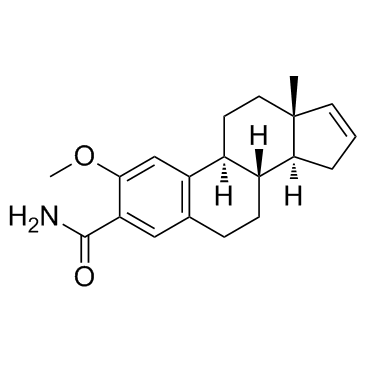864668-87-1
| Name | (8S,9S,13R,14S)-2-methoxy-13-methyl-6,7,8,9,11,12,14,15-octahydrocyclopenta[a]phenanthrene-3-carboxamide |
|---|---|
| Synonyms |
enmd-1198
ENMD-119 |
| Description | ENMD-119 is a 2-methoxyestradiol analogue with antiproliferative and antiangiogenic activity, and is suitable for inhibiting HIF-1α and STAT3 in human HCC cells. |
|---|---|
| Related Catalog | |
| Target |
STAT3 HIF-1α |
| In Vitro | ENMD-1198 inhibits the proliferation of endothelial cell HMEC-1 and BMH29L with IC50 of 0.4 μM and 3.8 μM, respectively. ENMD-1198 (0.5 μM) inhibits the formation of capillary tubes in HMEC-1 cells. ENMD-1198 also significantly inhibits capillary tube formation from 0.1 μM and suppresses endothelial cell morphogenesis at 1 μM. Moreover, ENMD-1198 at the IC50 for cell proliferation causes a significant decrease in VEGFR-2 expression both in the presence and in the absence of serum. ENMD-1198 inhibits endothelial cell motility, ENMD-1198 inhibits endothelial cell migration. ENMD-1198 rapidly induces extensive microtubule depolymerization and accumulation of actin stress fibers and large focal adhesions[1]. ENMD-1198 inhibits MDA-BO2 cancer cell viability with an IC50 of approximately 0.8 μM. ENMD-1198 has both an antiangiogenic effect and a vascular disruptive effect in vitro. ENMD-1198 reduces the viability of RAW264.7 osteoclast precursor cells and inhibits PTHrP-stimulated bone resorption. ENMD-1198 shows inhibitory activity against RAW264 with an IC50 value of approximately 0.4 μM and is shown to be 4 times more potent than 2ME2 (IC50 appro 1.6 μM)[2]. ENMD-1198 inhibits the phosphorylation of MAPK/Erk, PI-3K/Akt and FAK. Moreover, activation of HIF-1α and STAT3 is dramatically reduced by ENMD-1198, which results in lower VEGF mRNA expression. In addition, tumor cell migratory and invasive properties are significantly inhibited[3]. |
| In Vivo | ENMD-1198 (200 mg/kg/d, per oral gavage)-based combination treatments reduce tumor burden but does not eradicate the tumor in mice. ENMD-1198 treatment protects the bone against tumor-induced osteolysis in vivo[2]. ENMD-1198 (200 mg/kg/day, p.o.) leads to a significant reduction in tumor growth, tumor vascularization, and numbers of proliferating tumor cells[3]. |
| Cell Assay | To evaluate cytotoxic effects of ENMD-1198 on tumor cells, HUH-7 and HepG2 cells are seeded into 96-well plates (1×103/well; 12 wells per condition) and exposed to various concentrations of ENMD-1198 for 24 and 48 hours at 37°C. Methylthiazole tetrazolium (MTT) assay is used to assess cell proliferation. |
| Animal Admin | In brief, 2 holes are drilled through the bone cortex of the upper right tibia with a 25-gauge needle (25G 5/8) and bone marrow is flushed out. Subsequently, 250,000 MDA-BO2 cells/10 μL PBS is injected into the right tibiae of 6-week-old nude mice. Three days after intraosseous inoculation of MDA-BO2 cells, the animals are randomly divided in groups (n = 10). In a first experiment, 4 groups of mice (n = 10) receive either ENMD-1198 (200 mg/kg/d, per oral gavage) or CTX (30 mg/kg/d, through the drinking water) or a combination of ENMD-1198 and CTX or vehicle control. Treatment starts at day 7 after inoculation and is continued throughout the experiment. After 6 weeks, the animals are sacrificed by cervical dislocation and hindlimbs are fixed and kept for ex vivo X-ray analysis. In a second experiment, 4 groups of mice (n = 10) receive ENMD-1198 (200 mg/kg/d, per oral gavage) or ENMD-1198 + CTX (30 mg/kg/d, through the drinking water) or ENMD-1198 + CTX + risedronic acid (1.6 μmol/kg/d, by subcutaneous injection). |
| References |
| Molecular Formula | C20H25NO2 |
|---|---|
| Molecular Weight | 311.41800 |
| Exact Mass | 311.18900 |
| PSA | 53.31000 |
| LogP | 4.70050 |
